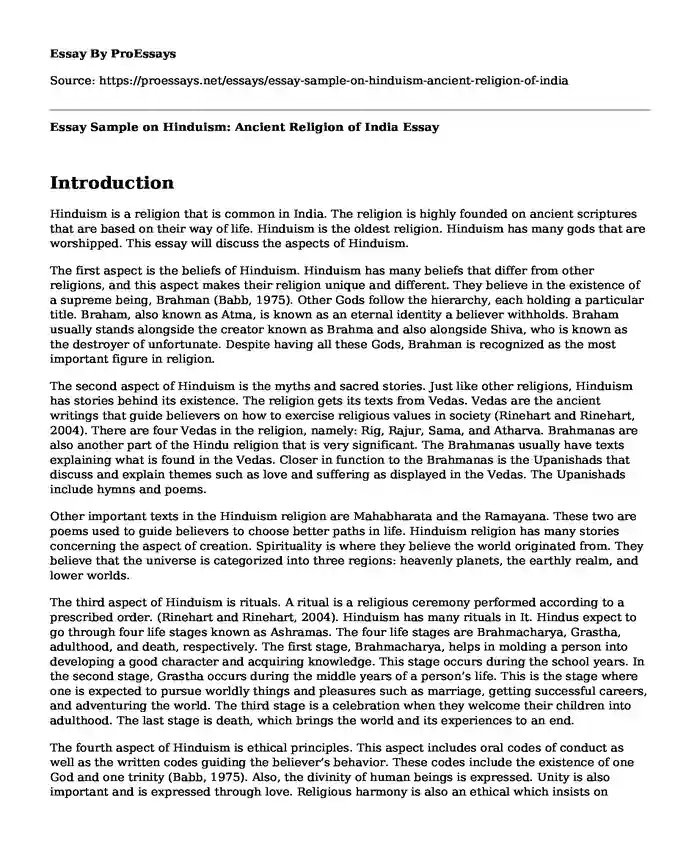Introduction
Hinduism is a religion that is common in India. The religion is highly founded on ancient scriptures that are based on their way of life. Hinduism is the oldest religion. Hinduism has many gods that are worshipped. This essay will discuss the aspects of Hinduism.
The first aspect is the beliefs of Hinduism. Hinduism has many beliefs that differ from other religions, and this aspect makes their religion unique and different. They believe in the existence of a supreme being, Brahman (Babb, 1975). Other Gods follow the hierarchy, each holding a particular title. Braham, also known as Atma, is known as an eternal identity a believer withholds. Braham usually stands alongside the creator known as Brahma and also alongside Shiva, who is known as the destroyer of unfortunate. Despite having all these Gods, Brahman is recognized as the most important figure in religion.
The second aspect of Hinduism is the myths and sacred stories. Just like other religions, Hinduism has stories behind its existence. The religion gets its texts from Vedas. Vedas are the ancient writings that guide believers on how to exercise religious values in society (Rinehart and Rinehart, 2004). There are four Vedas in the religion, namely: Rig, Rajur, Sama, and Atharva. Brahmanas are also another part of the Hindu religion that is very significant. The Brahmanas usually have texts explaining what is found in the Vedas. Closer in function to the Brahmanas is the Upanishads that discuss and explain themes such as love and suffering as displayed in the Vedas. The Upanishads include hymns and poems.
Other important texts in the Hinduism religion are Mahabharata and the Ramayana. These two are poems used to guide believers to choose better paths in life. Hinduism religion has many stories concerning the aspect of creation. Spirituality is where they believe the world originated from. They believe that the universe is categorized into three regions: heavenly planets, the earthly realm, and lower worlds.
The third aspect of Hinduism is rituals. A ritual is a religious ceremony performed according to a prescribed order. (Rinehart and Rinehart, 2004). Hinduism has many rituals in It. Hindus expect to go through four life stages known as Ashramas. The four life stages are Brahmacharya, Grastha, adulthood, and death, respectively. The first stage, Brahmacharya, helps in molding a person into developing a good character and acquiring knowledge. This stage occurs during the school years. In the second stage, Grastha occurs during the middle years of a person’s life. This is the stage where one is expected to pursue worldly things and pleasures such as marriage, getting successful careers, and adventuring the world. The third stage is a celebration when they welcome their children into adulthood. The last stage is death, which brings the world and its experiences to an end.
The fourth aspect of Hinduism is ethical principles. This aspect includes oral codes of conduct as well as the written codes guiding the believer’s behavior. These codes include the existence of one God and one trinity (Babb, 1975). Also, the divinity of human beings is expressed. Unity is also important and is expressed through love. Religious harmony is also an ethical which insists on having affection for different religions. Knowledge of the 3Gs is also emphasized (Rinehart and Rinehart, 2004). These are Ganga, the sacred river, the sacred script, Gita, and Gayatri, the sacred mantra. Dharma is also included, which emphasizes on every human being having a duty. Finally, karma is a belief in life, death, and rebirth. Karma can be improved by Yamas, which includes yoga and visits to the temple.
Conclusion
The uniqueness of Hinduism religion is evident in its aspects. Religion is founded on ancient beliefs, intertwined with society, to make life and society better. The aspects of Hinduism clearly show how religion is deeply entrenched to its beliefs.
References
Babb, L. A. (1975). The divine hierarchy: Popular Hinduism in central India. Columbia University Press. https://books.google.com/books?hl=en&lr=&id=KsJKNbszQ7MC&oi=fnd&pg=PR9&dq=Babb,+L.+A.+(1975).+The+divine+hierarchy:+Popular+Hinduism+in+central+India.+Columbia+University+Press.&ots=LJ6KhaL-2H&sig=jstaoyncTvIc1DrW-7GrdZ7sNuY
Rinehart, R., & Rinehart, R. (Eds.). (2004). Contemporary Hinduism: Ritual, culture, and practice. ABC-CLIO. https://books.google.com/books?hl=en&lr=&id=hMPYnfS_R90C&oi=fnd&pg=PR5&dq=Rinehart,+R.,+%26+Rinehart,+R.+(Eds.).+(2004).+Contemporary+Hinduism:+Ritual,+culture,+and+practice.+ABC-CLIO.&ots=bnwVOZLUcW&sig=FG8of6ZYcN_-01Tvprzu0YBKWjI
Cite this page
Essay Sample on Hinduism: Ancient Religion of India. (2023, Sep 15). Retrieved from https://proessays.net/essays/essay-sample-on-hinduism-ancient-religion-of-india
If you are the original author of this essay and no longer wish to have it published on the ProEssays website, please click below to request its removal:
- Essay Sample on Spiritual Care
- Incarnation and Presence in Religion Essay Example
- Essay Example on Confucianism: A Vital Force in Arising China's Social Structures
- Essay Example on Psychology, Christian Faith, and the Search for Truth
- Islam: One God, One Creator, One Universe - Essay Sample
- Essay Example on Money & Savings in the Bible: Risk, Return & Opportunity Cost
- The Bible's East-West Impact: Vishal Mangalwadi's Insightful Exploration - Essay Sample







